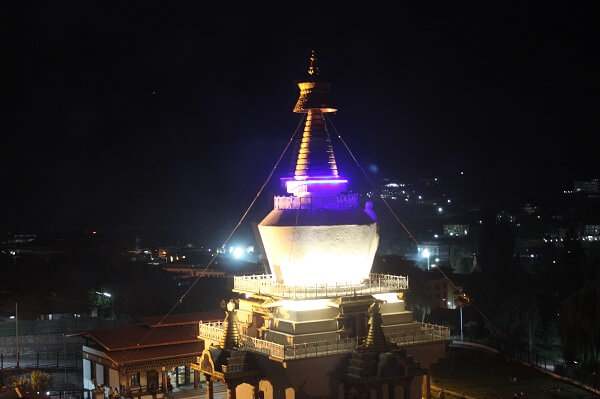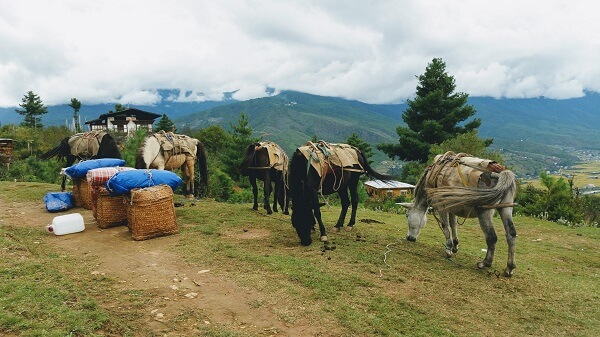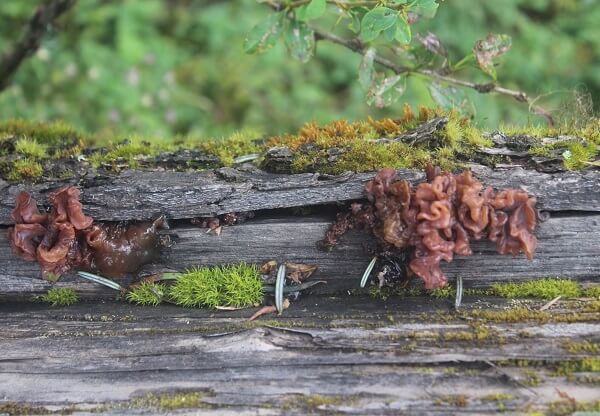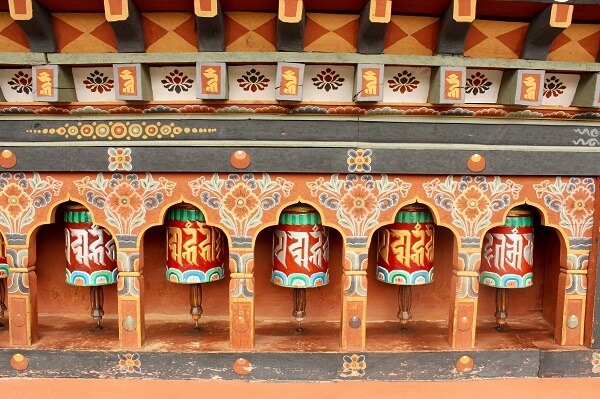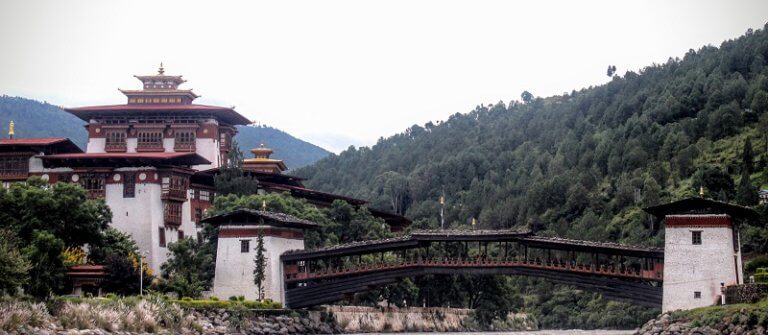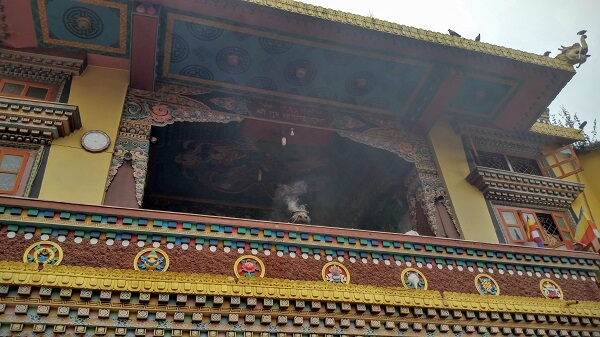
Melanie 11 September 2016 Kathmandu to Paro
Our day began in Kathmandu and ended in Paro.
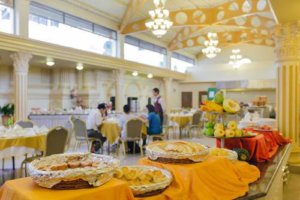 We wound our way down through the hotel and into the Hotel Shanker dining room – striding towards breakfast. The first room is dim and lifeless. We know now – follow the path – we keep going – through this room we find another similar – we keep going – finally we emerge into a huge ballroom sized room – Aaah finally breakfast.
We wound our way down through the hotel and into the Hotel Shanker dining room – striding towards breakfast. The first room is dim and lifeless. We know now – follow the path – we keep going – through this room we find another similar – we keep going – finally we emerge into a huge ballroom sized room – Aaah finally breakfast.
The buffet is scattered throughout the room and throughout the worlds’ cuisines. Waiters buzz around the room offering service and assistance. One man is dedicate to service of tea/coffee on a trolley. Multiple breakfast options were available including European and an Indian selection of curry, rice and Puri – something for each of us. Rarely do you see such service and variety elsewhere.
Dibash met us at 8.30 despite some tough negotiation on our part to sleep in! Oh what a time we have had in Kathmandu. It created discussion on the benefits of a guide to introduce you to a place particularly when time is short and history is extensive. As we wandered through the market a young woman came up to us and said “Do you mind if I ask your guide a question?” As we looked on while Dibash helped out I thought we would not have visited or learned as much without Dibash and Alpine Asia Trek and Day Tours. The visit would have been superficial – and I believe also overwhelming.
Even crossing the road was a nightmare helped by sticking close and learning from Dibash – “slowly slowly” he would say when every instinct told you to run like hell to the other side.
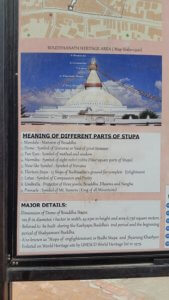 First a visit to one of the largest Stupa in the world Bouddhanath badly damaged in the 2014 earthquake it is being rebuilt
First a visit to one of the largest Stupa in the world Bouddhanath badly damaged in the 2014 earthquake it is being rebuilt
As we circled the Stupa Dibash asked if we wanted to enter the temples – we declined feeling uncomfortable. Finally he encouraged us to enter one where we discovered a large golden prayer wheel at the entrance. Further inside lines of monks were chanting. Upstairs a view of the stupa.
We learned to circle a Stupa 3 times in a clockwise direction. Commonly the mantra is ‘Om Mani Padme Hum’.
Our final visit was to Pashupatinath Temple on the banks of the Bagati River – this river later meets the Ganges and is sacred. The temple is a very important temple to Shiva.
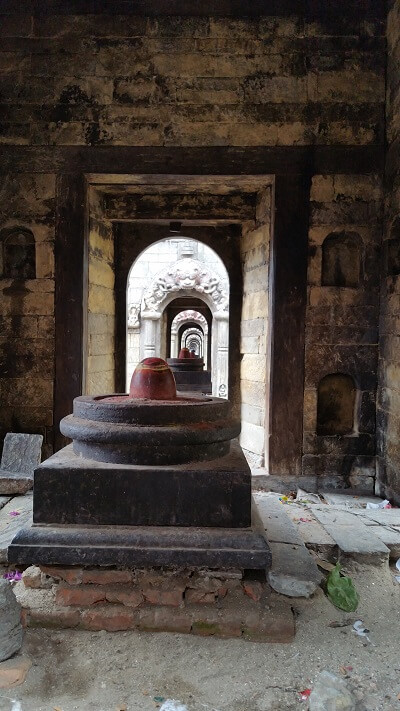
Throughout the temple grounds and along the river are symbols of the deity Shiva. This is the lingam – an erect phallus. Throughout the temple and riverside there were Sadhus covered with paint, there stark lives are contrasted with (to our Western eyes) their exotic appearance.
The temple containing a huge statue of a bull is only accessible to Hindu followers. Here people were in selfie overload taking photos as they entered this sacred temple. The golden rump of the huge statue of the bull visible through the temple gates.
Lining the river were Ghats where slabs reaching out into the river could hold bodies and cremations were held. On the other side of the river were slabs were rituals and family gatherings happened. Chris found it unwatchable – I found it comforting – death as a part of life. That sounds trite but watching a body be clothed and prepared for burning, watching a family grieving in amongst daily life along the river – it made dying a part of life.
Lunch at a small simple cafe near the hotel. I had a bowl of Chicken Thukpa – a bowl of enviable, soupy, deliciousness. Chris had his standard MoMos.
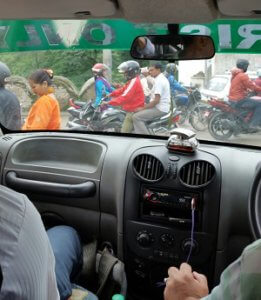 As we travelled out to the airport through the incredible movement (or not) of traffic we past a large expanse of UN tents that appeared to be Internal Displaced Persons camp. Directly next door was a large Grand Hyatt hotel. An punchy reminder of the contrast between we as tourists and lives of people affected by poverty and the earthquake.
As we travelled out to the airport through the incredible movement (or not) of traffic we past a large expanse of UN tents that appeared to be Internal Displaced Persons camp. Directly next door was a large Grand Hyatt hotel. An punchy reminder of the contrast between we as tourists and lives of people affected by poverty and the earthquake.
Getting through the check-in process proved a little tetchy. Trying to repack bags on the fly and find our way through the airport with one striding out in front proved too much for our lovely Buddhist calm! Recovery was aided by a little respite in the airline lounge with grateful thanks to our credit card perks.
Strolling out to get to our plane we discovered a massive long line at security – of men. As I was waved through to another entrance with no queue and for women only. Met another woman waiting for her husband on the other side and had a lovely chat while we waited.
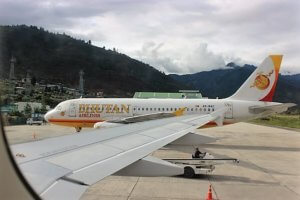 Finally onto our little Druk air flight to Paro. We were not able to get a right side seat – necessary to view the Himalayas but the Himalayas were hiding behind heavy cloud anyway.
Finally onto our little Druk air flight to Paro. We were not able to get a right side seat – necessary to view the Himalayas but the Himalayas were hiding behind heavy cloud anyway.
The arrival in Paro airport a complete contrast to what we had left. Few people around, quick and efficient processing, a huge spotlessly clean airport.
We were out in a flash and immediately greeted by our World Tour Plan guide Tshering – our guide for the next 3 weeks, Dorji our driver also with us for all – except our trek.
Our sightseeing began immediately. On the drive from Paro to Thimpu we stopped at Tachogang Temple with its rather terrifying Tachogang Lhakhang suspension bridge over pounding waters in the river below.
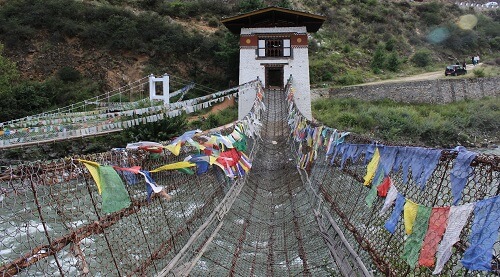
It is also our first meeting of “the big three” of Buddhism in Bhutan – Guru Rinpoche, who first brought Buddhism to the Himalayas in the 8th Century, Buddha himself, and Shabdrung, the first to consolidate Bhutan into a unified country in the 1600s. In days to come we would learn more, meditate with them and become much more familiar. For today it was a mural at the temple entrance.
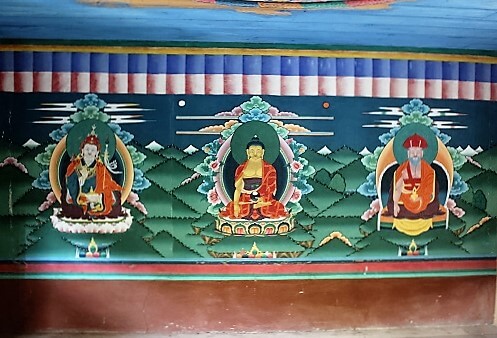
And on to Tashi Yoedling our hotel for the next few days. Immediately captivated by the view from our window across the road to the Thimpu Chorten
